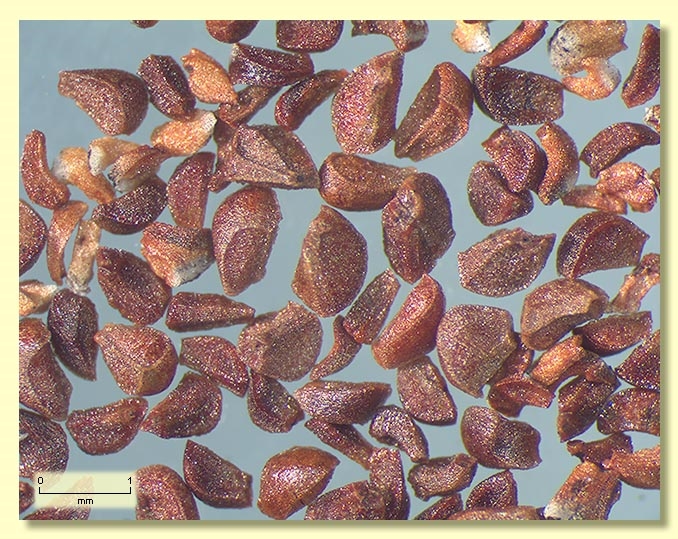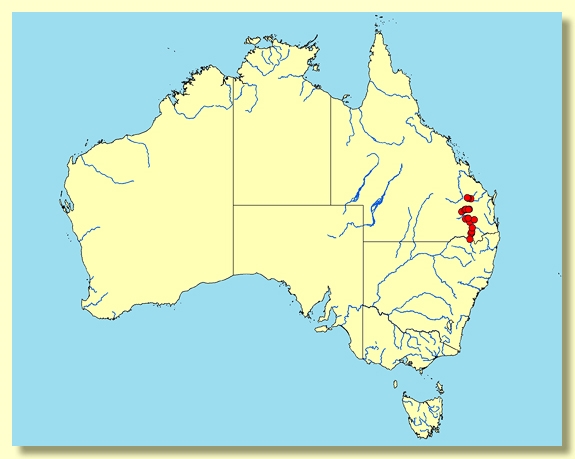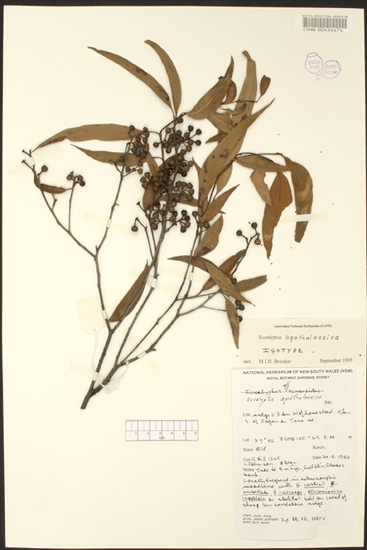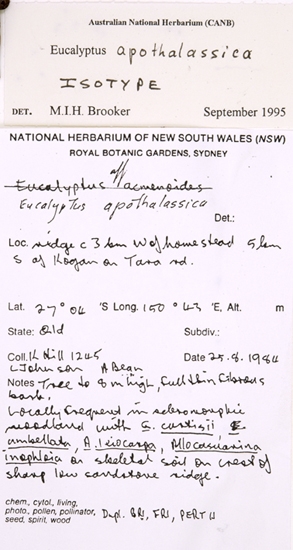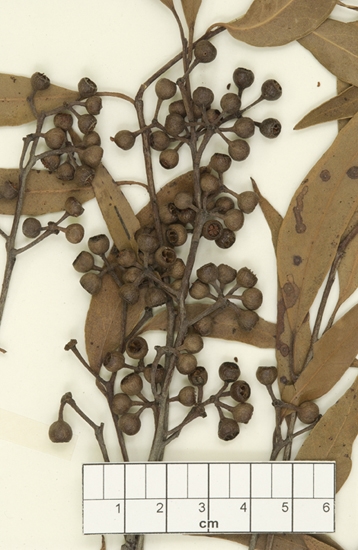Euclid - Online edition
Eucalyptus apothalassica
Eucalyptus | Eucalyptus | Amentum
Bark rough throughout, grey or grey-brown, fibrous, sometimes prickly to touch, held on trunk in flattish strips rather than typical stringybark.
Juvenile growth (coppice or field seedlings to 50 cm): stem rounded in cross-section; juvenile leaves opposite and sessile for at least 10 pairs then becoming alternate, petiolate, ovate to lanceolate, 6.5–14 cm long, 2–4.2 cm wide, discolorous, slightly glossy, green or blue-green.
Adult leaves alternate, petiole 0.5–2.3 cm long; blade lanceolate to falcate, 5–13(14) cm long, 0.9–2.5(3) cm wide, base oblique or tapering evenly to petiole, margin entire, concolorous, dull or glossy, green, side-veins between ca 40° and 50° to midrib, moderately to densely reticulate, intramarginal vein parallel to and well removed from margin, oil glands island, intersectional or obscure.
Inflorescence axillary unbranched but often clustered towards the ends of branches and may appear to be terminal, peduncles 0.5–2.3 cm long, buds 11 to 15 per umbel, pedicels 0.3–0.4 cm long. Mature buds ovoid to fusiform, 0.5–0.6 cm long, 0.3 cm wide, green to yellow, scar absent, the single operculum shedding at flowering, operculum conical to beaked, stamens irregularly flexed, anthers reniform to cordate, versatile, dorsifixed, dehiscing by confluent slits, style long, locules 3 or 4, the placentae each with 2 vertical ovule rows. Flowers white.
Fruit pedicellate (pedicels 0.2–0.5 cm long), truncate-globose to hemispherical or barrel-shaped, (0.3)0.4–0.6 cm long, 0.4–0.6(0.7) cm wide, disc descending vertically or concealed, valves 3 or 4, usually near rim level, rarely either exserted slightly or fully enclosed.
Seeds brown, 1–2.5 mm long, pyramidal or obliquely pyramidal, dorsal surface smooth, hilum terminal.
Cultivated seedlings (measured at ca node 10): cotyledons reniform; stems rounded in cross-section; leaves opposite and sessile for ca 9 or 10 nodes, ovate to lanceolate, 9–15 cm long, (1.5)3–4.5 cm wide, base amplexicaul to rounded, discolorous, green, becoming slightly glossy.
Flowering has been recorded in October.
A small to medium-sized tree of dry sclerophyll forests and woodlands on sandstone-derived soils from the Yetman area of the North Western Plains of New South Wales extending north to Inglewood, Kogan, Barakula State Forest, Yarraman and the Eidsvold to Cracow area. Eucalyptus apothalassica is completely rough-barked, with a green crown of concolorous leaves with densely reticulate venation, ovoid buds with conical to beaked operculum, small fruit that vary from hemispherical to truncate globose or barrel-shaped and with the disc descending and concealed, and lanceolate juvenile leaves placed in opposite pairs on the stem.
Within its natural range E. apothalassica is only likely to be confused with stringybark species but can always be distinguished by the dense reticulate venation in the adult leaves. (Stringybark species are always sparsely reticulate.) The small fruit, only 0.4–0.7 cm wide with a thin rim and concealed disc, will also separate it from the stringybarks. The bark of all white mahogany species is shorter-fibred, often feels prickly and is more matted compared with that of stringybark species.
To the north and east of the distribution of E. apothalassica are several other species of white mahogany. The widespread E. acmenoides has a more coastal distribution in higher rainfall areas and is distinguished by the consistently strikingly discolorous adult leaves. Similarly the restricted E. helidonica has obviously discolorous adult leaves, and occurs only in the Helidon to Crows Nest area of Queensland. E. carnea has a sub-coastal distribution south from Gympie and has fruit slightly larger (but with some overlap in dimensions) and with a visible disc, and adult leaves that are often bluish green and always dull. E. mediocris occurs to the north and north-west of the distribution of E. apothalassica and differs only in having slightly larger fruit (but with some overlap in dimensions), and perhaps narrower juvenile leaves, but this requires further investigation.
MORE ABOUT WHITE MAHOGANIES





